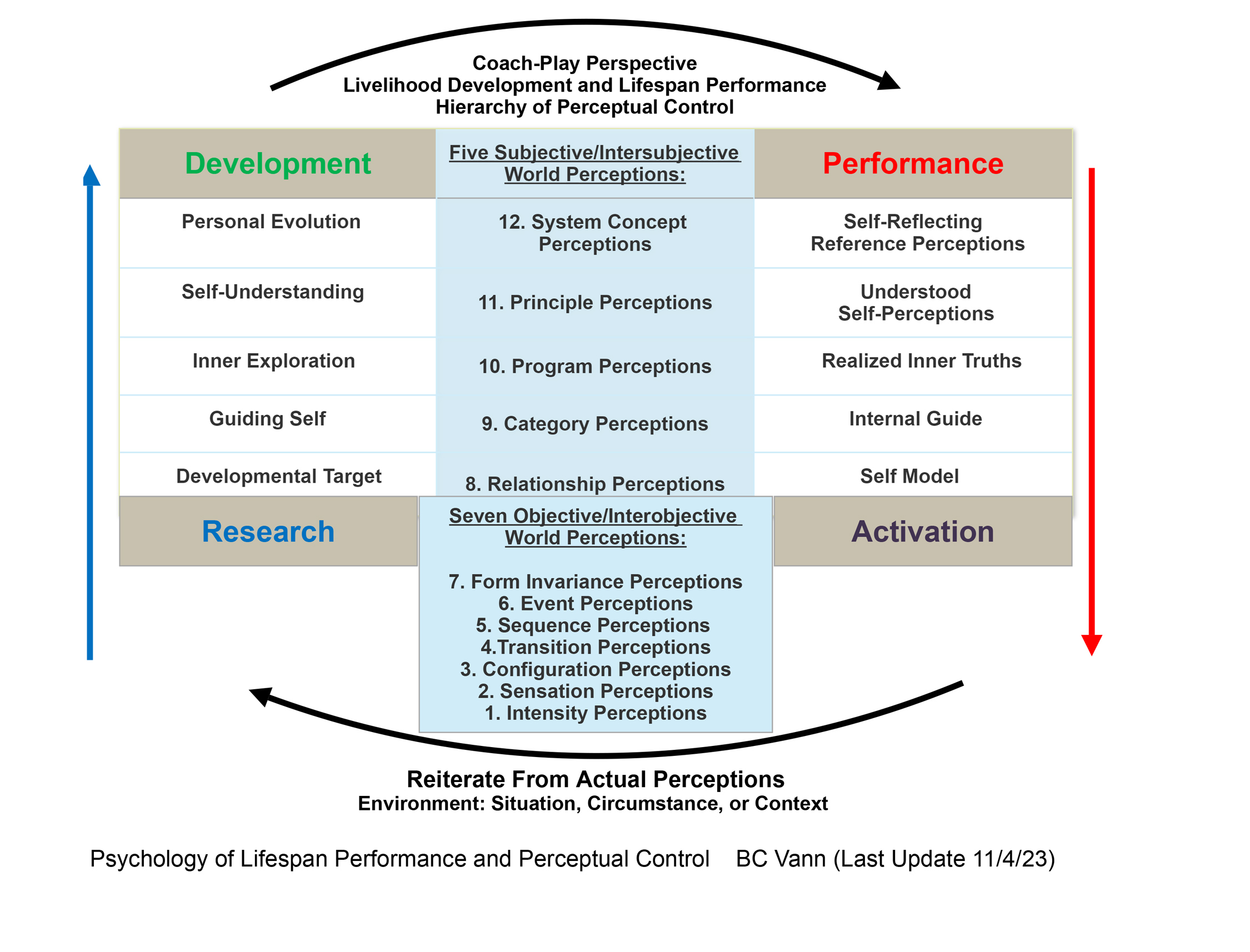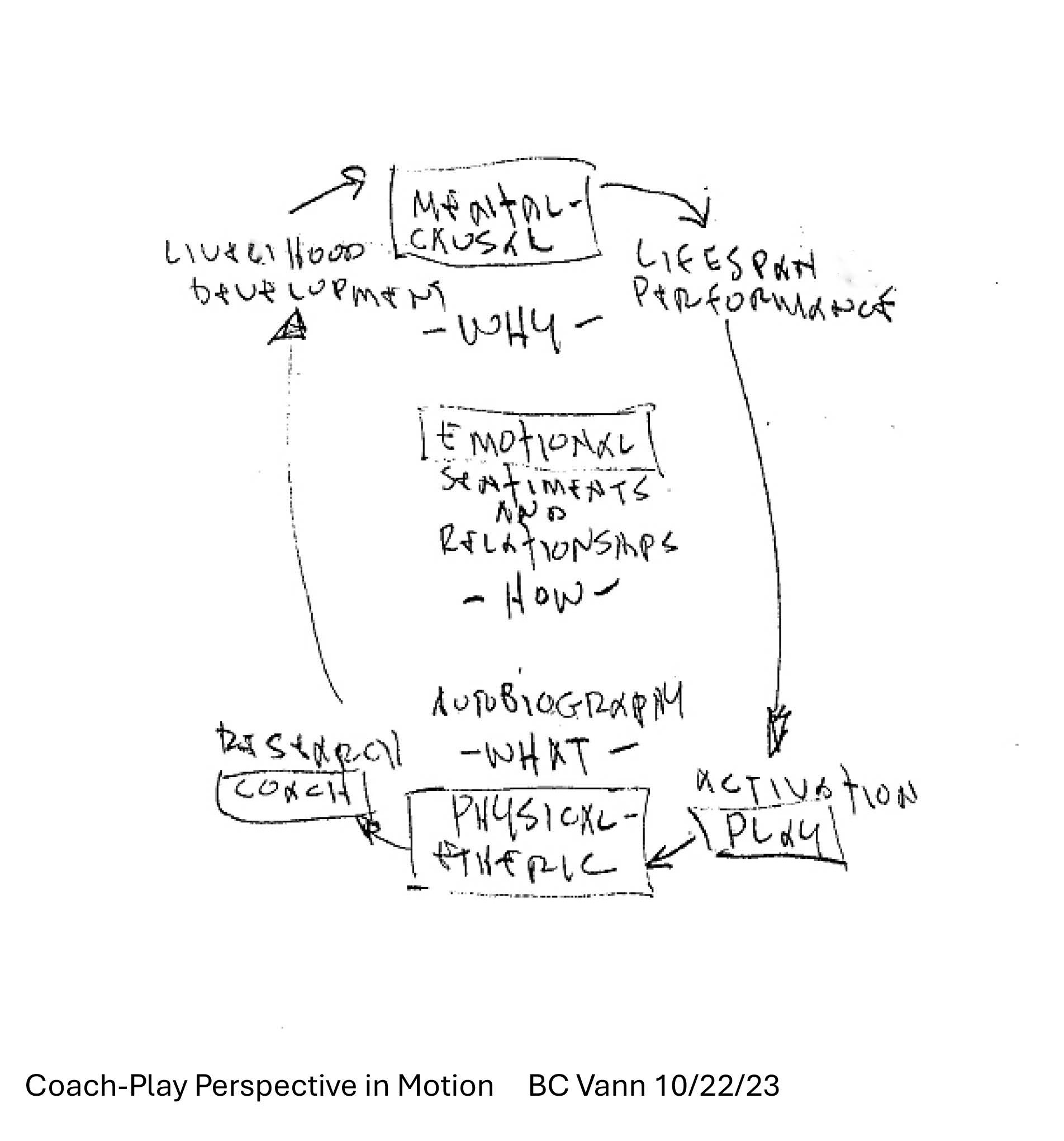As Your Resource For Self-Development
- The Optima Bowling Coach (2025)
Human Development: From Fragmentation to Wholeness
(Page Updated 5/30/25)
Optima Bowling approaches human development as neither a single psychological construct nor a loose collection of self-help tips but a dynamic systems-of-systems in which nested control loops, layered meanings, and evolving identities interweave across the lifespan. This page presents that terrain in full, showing how the progression from infancy to integrated maturity unfolds through the perceptions that guide all Optima Bowling content (most centrally) the Psychology of Lifespan Performance and Perceptual Control (LPPC) model, the Purpose Integrity Experience (PIE) triad, the Craziness Scale, and the overarching mandate to transform potentiality into actuality. This discussion crystallizes how scattered impulses can cohere into a resilient, purpose-driven self and how personal coherence repairs frayed cultural fabric.

The Systemic Foundations of Growth
Human development begins before language, in primal loops that regulate temperature, hunger, and protective attachment. LPPC charts these early operations at their lowest tiers (intensities and sensations). The infant’s nervous system compares biological set‑points against fluctuating inputs and demands corrective action through cries, rooting reflexes, or limb flails. These crude feedbacks mark the inaugural bridge from innate latent genetic potentiality to manifest intrinsic physiological actuality.
Loops diversify into the emotional tier as the child stabilizes, tracking attraction and repulsion toward caregivers, toys, and novelty. Optima’s Craziness Scale (designed initially to diagnose adult disintegration) already flickers here: secure toddlers display harmonious feedback, exploring confidently and recalibrating through a glance at a parent; fragmented toddlers oscillate between cling and avoidance. The scale thus reveals that wholeness is not a distant ideal but an emergent property observable from the earliest developmental phases.
Differentiation and the First Crisis of Fragmentation
With speech comes the mental tier: symbols, time concepts, and counterfactual imagination. This cognitive burst differentiates the self from others, the present from the future, and desire from the rule. Differentiation is essential, for without it, the organism cannot refine higher‑order references. Yet differentiation also seeds fragmentation. A child’s new linguistic loop may clash with visceral emotion: I want the cookie vs. I’m told to wait. Successful guidance helps the child create meta‑loops that mediate impulse and rule, apprenticing the earliest form of self‑governance.

PIE illuminates the mediator’s architecture. Purpose frames why delaying gratification matters (“so that playtime lasts longer”). Integrity ensures the rule aligns with bodily fully supplied rather than adult convenience. Experience supplies practice rounds—small waiting games that embed victory into muscle memory. In the LPPC stack, these mediating loops emerge at the relationship and program levels; once stable, they liberate executive resources for learning, friendship, and creativity. If mediation fails, the Craziness Scale tilts downward as conflicting loops jam attention, a pattern that can echo through adolescence unless re‑integrated.
Adolescence: Expanding Horizons, Multiplying Conflicts
Teen years rupture the tidy order of middle childhood: hormonal storms amplify emotions, peer norms challenge family scripts, abstract principles (justice, identity) gallop ahead of practical wisdom. LPPC registers a surge in relationship and principle‑level experimentation. The adolescent tests who I am by controlling clothing, playlists, and political slogans (public signals that aim to align inner reference with social perception).
From Optima’s angle, the key developmental task is integrative differentiation, which expands the portfolio of loops without shredding coherence. The Craziness Scale often vacillates wildly (i.e., euphoria on Monday, nihilism on Friday) because novel loops have not yet meshed. Mentors can employ the PIE triad as scaffolding: clarify the Purpose of each experiment, insist on Integrity across physical health and emerging ethics, and demand lived Experience instead of online posturing. Well‑guided, the teen begins weaving a personal mythos capable of holding contradiction without collapse.
See More: Craziness Scale and Personality Development
Early Adulthood: Crafting a Provisional Order
Early adults consolidate identity through career choice, partnership, and civic stance. These commitments elevate LPPC operations to the program and, increasingly, principle levels. A nurse refines protocols that stabilize patient outcomes; a community organizer articulates values of equity and empowerment. Each role cultivates specialized competence, tightening certain loops while nudging others into dormancy.
Such focus accelerates success yet risks sectoral wholeness, coherence within a narrow domain, and neglect elsewhere. The Optima framework counters by encouraging periodic reference audits across the Systemic Levels of Being Human. A thriving professional life means little if emotional feedback loops languish in isolation. The Craziness Scale detects these imbalances: chronic fatigue, dulled curiosity, and relational friction. Re‑integration requires upgrading principle‑level references (i.e., balance, creative renewal, service) so that burgeoning actuality does not cannibalize dormant potentiality.
Midlife and the Call to Causal Integration
Midlife often punctures the provisional order with mortality salience, plateaued progress, or ethical disquiet. LPPC models this turbulence as error spikes at the principle and system‑concept tiers. The professional who once measured success by promotion now asks what the promotions served; the parent whose children launch wonders who they have become. This existential error cannot be resolved by tinkering with lower loops; it demands recalibration at the causal tier (the zone of ultimate meaning).
Optima Bowling suggests a PIE inversion at this stage: instead of Purpose sparking action, Experience (caregiving, loss, awe) provokes reflection, which re‑writes Integrity and only then crowns a new Purpose. The Craziness Scale may dip sharply before rising: fragmentation signals outdated references meeting fresh data. Those who embrace the discomfort develop what the framework calls Generative Wholeness: an identity porous enough to integrate contradictions yet firm enough to steer through them.
Late Adulthood: Stewardship and Transcendence
Later in life, the LPPC hierarchy often inverts again. Sensory and physical loops fray, yet causal awareness matures. Elders who achieved generative wholeness re‑deploy attention outward, mentoring younger cohorts and curating cultural memory. Here, the “private loops → public order” theme reaches its apogee: decades of personal refinement crystallize into wisdom traditions, institutions, or artistic legacies that guide collective loops long after the individual is gone.
The Optima Bowling ideology does not romanticize aging; degeneration of configuration‑level control can spike the Craziness Scale without social support. Nonetheless, system-concept coherence buffers physical fragility when causal references remain luminous (i.e., service, wonder, humility). The final developmental milestone becomes Transcendent Integration: relinquishing narrow ego references while amplifying humane principles in communal consciousness.
Healing Fragmentation: Strategies Across the Lifespan
Across all epochs, three recurring strategies stitch scattered loops into functional wholes.
- Iterative Reference Setting: Each life stage benefits from revisiting “Why?” The question is not redundant; it upgrades Purpose in response to an unparalleled Experience; one sentence in Optima coaching dialogues (clear, value‑rooted, stage‑appropriate) anchors months of developmental experimentation.
- Cross‑Tier Alignment Checks: Fragmentation often hides at tier junctions: a mental goal that contradicts emotional truth, a causal belief that starves the body. Quarterly audits (physical metrics, feeling logs, narrative journals, existential dialogues) reveal misalignment before it metastasizes.
- Error Signal Reframing: The Craziness Scale reframes anxiety, cynicism, or boredom as data: invitations to upgrade references, not indictments of character. This shift transforms defensive denial into curious iteration, propelling growth through adaptive cycles rather than crisis lurches.
The Social Echo: Personal Wholeness as Cultural Repair
Optima Bowling’s systemic vision insists that individual maturation is inseparable from collective evolution. The more coherent a person’s loops, the more reliable their participation in public feedback: democratic deliberation, fair trade, and ecological stewardship. Conversely, mass fragmentation (fuelled by information overload, exploitative algorithms, or unjust economics) feeds back into personal loops as chronic stress and polarity. Thus, integrating fragmentation and wholeness is simultaneously a therapeutic, pedagogic, and civic mandate.
The mechanism is recursive. A new parental leave policy emerged because countless caregivers flagged error signals—burnout, missed milestones—and lobbied for principle‑level reform. Once enacted, the policy modifies lower loops for future parents, improving systemic coherence. In control‑theoretic terms, culture is a meta‑controller adjusting collective references in response to aggregated private error.
Toward Lifespan Mastery: Potentiality Realized
The human organism maintains astonishing reservoirs of capacity: neural plasticity, empathic resonance, symbolic abstraction, and ethical imagination. Development is the incremental actualization of these potentials through increasingly refined control loops. Yet, there is no final plateau. Each realization becomes the platform for subtler possibilities: intellectual humility after expertise, planetary citizenship after national pride, spiritual compassion after personal tranquility.
Optima Bowling, therefore, describes adulthood not as arrival but as stewardship: maintaining wholeness amid complexity while cultivating contexts that ease others’ climb. The LPPC stack remains the map, the PIE triad the compass, and the Craziness Scale the altimeter. Together, they enable lifelong travelers to navigate storms, reroute around the blockage, and savor vistas unreachable to fragmented selves.
The Definitive Integration
Human development, viewed through Optima’s systemic optic, is the art of orchestrating nested perceptual loops until the melody of life resounds in balanced harmony. Fragmentation is not failure; the discord signals growth’s next interval. Wholeness is not stasis; it is a dynamic equilibrium tuning body, emotion, mind, and spirit to a shared key. Potentiality forever beckons beyond its current form, and actuality responds through iterative, purposeful, integrative experience.
By mastering the grammar of control (perception, reference, action), individuals ascend the LPPC hierarchy, express their purest humanity, and, in so doing, weaving a stronger social fabric. Optima Bowling offers the instruments; the symphony is yours to play, generation after generation, loop after loop until the music of wholeness enfolds us all.
See More: The Livelihood and Lifespan Relation
See More: Transition From Ignoring to Working Upon
See More: Research for Development